Lost in time: Exploring the rugged Faroe Islands
18 tiny islets make up the Faroe Islands, an archipelago of ancient traditions, long summer nights and wild landscapes. Sarah Stirling couldn’t resist their lure…
All I could see was a metre radius around my own feet. Strings of dew pearls gleaming along every grass stalk reminded me that, when you can see it, the Faroes’ combination of rain-soaked landscape and cold northern light has a magical quality, vibrant like a saturated photo, or shimmering and sparkling in dreamy pastels.
The peace was shattered by a bleak cry ringing across the mountainside, followed by frantic rustling: a row of brightly coloured, Gore-tex-wrapped dominoes trying to right themselves.
We listened, ears cocked like satellite dishes. Sounds travelled deceptively quickly in the dense fog: the noise could have come from anywhere.
“I think I can hear the sea,” reported David.
“Don’t be daft, that must be a babbling mountain brook,” snorted Bill, seasoned Faroes visitor and self-nominated group leader. “Unless we went too low, and are approaching the cliffs below the lighthouse.” His eyes widened, making mist drops jiggle on his eyebrows and lashes. Bill doesn’t like heights. He doesn’t like them at all!
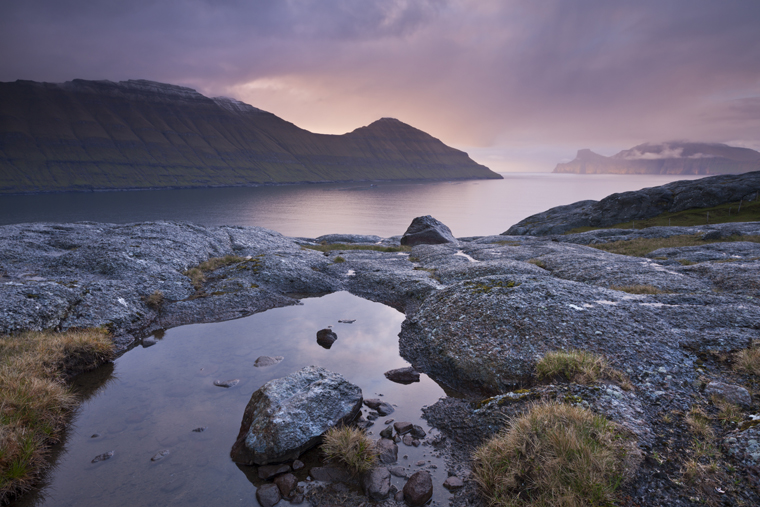
A view of the Isle of Tindholmur from Vagar Island – rockpool-topia! | Adam Burton/visitfaroeislands.com
Another cry, louder this time, and my fingers tightened their grip on David’s jacket. Then a shape, what looked like a giant hairball, emerged from the mist.
Remember that jumper worn by Sarah Lund in The Killing? When the dark, Danish detective series became a surprise international hit, everyone wanted to know where they could get one like it. The world’s attention fell on a tiny archipelago, alone, storm-battered and largely forgotten about 200 miles north-northwest above Scotland, where everyone wears homespun traditional knitwear like emblems of national pride.
Faroese jumpers seem to have an ancient wisdom about life entwined with nature knitted into them in mesmeric geometrics, I reflected. How do they capture that? I stared at a Faroese sheep, getting jumper-lust. It ran away. These islands breed reticent, canny survivors on all fronts, as we had found out.
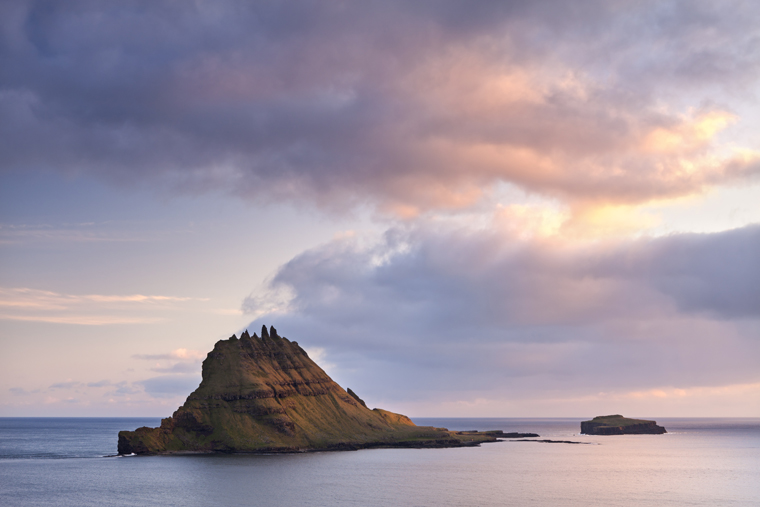
The islet of Tindholmur |Adam Burton/visitfaroeislands.com
The smallest inhabited Faroe Isle reveals the essence of life here. To get to diamond-shaped Stora Dimun, you jump onto rocks (it’s impossible to land), cling onto a rope and scale a huge cliff using old puffin burrows and slippery rocks for footholds. Only one family lives there, and the grandfather is the first Dimun farmer to reach old age. Probably because they get about by helicopter nowadays.
More about that mode of transport shortly, but basically, the Faroe Islands are not a destination for the faint-hearted. The Tourist Office told us there are few orgasms here, which is not surprising considering the inhospitable conditions. In August, temperatures might soar into the low teens, but probably won’t. You need thermals for a summer holiday here.
On reflection though, perhaps the Tourist Office meant ‘organisms’. There aren’t many of those here, either. Not much grows in the shallow soil and strong wind. If it does, sheep eat it. They tried to plant a national forest once, but it blew away. Children’s trampolines, picnic tables and unfinished buildings all have to be tied down.

The village of Gasadalur on Vagar Island | Adam Burton: Visit Faroe Islands
Because these changes in weather blast through unpredictably anyway, we’d decided to when-in-Rome and walk despite the gathering fog. A red and white striped flashing lighthouse tower had seemed a sensible target. Now though, I recalled an ambiguous translation I’d read in a Visit Faroes pamphlet: ‘This walk is physically demanding and you should not be scared of heights, but it can be highly recommended.’
Sea cliffs in the Faroes are not to be underestimated. In fact, Viooy’s Cape Enniberg, the tallest, towers 750m above the thrashing North Atlantic. That’s 7.5 times the height of Big Ben. The Faroese casually climb down their many vast sea cliffs to collect sea bird eggs to eat. If sheep get stuck on cliff ledges, they hoick them back up with traditional carved crooks.
Are you still with me? Good. Don’t worry about us, suddenly remembering we weren’t Faroese, clutching each other’s coat-tails and inching towards a potential precipice. Only hardy, adventure-loving travellers should contemplate the Faroe Islands. Now I’ll let you in on all the secrets…
Imagine 18 tiny islets (you’re never more than three miles from the sea) scattered in arrowhead formation, 139 miles from anywhere between Iceland, Norway and the Shetland Isles. In some ways they resemble long-lost chunks of each of these beautiful places, but having their own unique character, too.
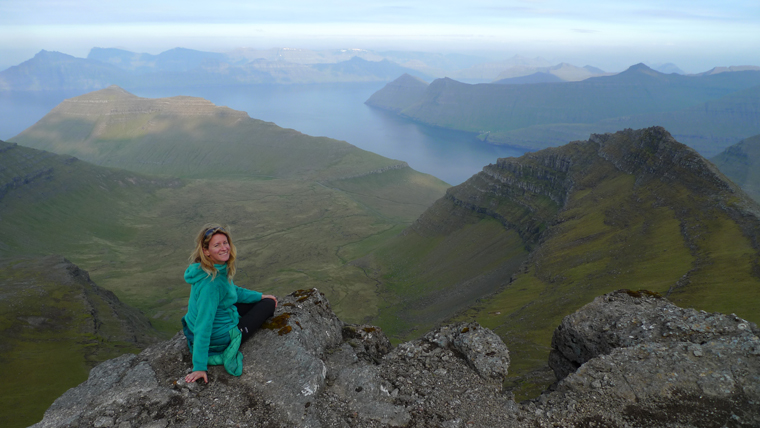
Sarah takes in the views | David Stewart / walkingworld.com
Over millennia of isolation each island developed its own quirks. Mykines is a remote bird paradise stuffed with puffins, for example, while Southern Sandoy has the Faroes’ best sandy beach and mildest climate (still, leave the bikini at home).
Nowadays these characterful mini-worlds are ideal for done-in-a-day hikes. In fact you can easily and cheaply travel between the Faroe Isles by subsea tunnel and helicopter. That’s because ‘tunnel fever’ overtook the Faroese in the 1960s when they realised the life-changing possibilities, and now there are lots of them. Helicopters, meanwhile, have been subsidised by the government for local transport since the 1980s. It only cost us around £10 each per flight. I know. Don’t tell anyone.
After arriving from Stansted on our first day, it took just an hour to drive across three islands and up to the mountainous far north, where the Faroes’ highest mountain, Slaettaratindur, stands on eastern Eysturoy. As we hiked up its grassy slopes, the sinking sun was casting soft pink and dove-grey stripes of light into a fjord below. Silhouetted birds wheeled in the beams. Then, after a short, sharp scramble, we were on a rocky flat top which disconcertingly resembled a sacrificial altar, gazing around at a fantastical dreamscape from 882m up.
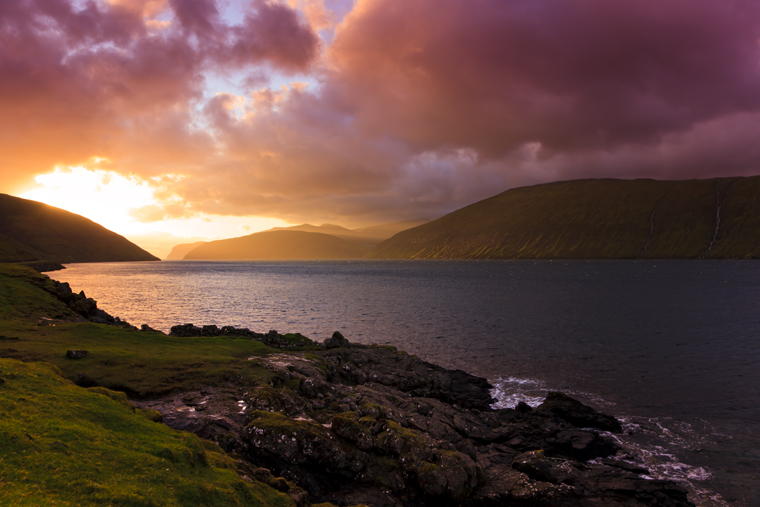
Fabulous coastal scenery on Vagar Island | Kimberley Coole
In the sunshine, the Faroes is heaven. Imagine a layer cake of bright, soft grass tiers sandwiched with bands of cooled lava. In your mind’s eye, slice it into arrestingly-sharp shapes surrounded by thrashing ocean: square sea stacks, pyramidical mountains, vertical cliffs and flat sugarloaf tops. These islands built up from the seabed millions of years ago and were carved out by
ancient glaciers.
Below Slaettaratindur we found the hobbit-like village of Gjogv (‘The Cleft’) clinging to the top of a narrow, 200m-high gorge. Like all the Faroese villages we’d seen, it was painted bright primary colours, topped with turf or tin roofs and built in simple shapes, like Lego. Puffins pottering clownishly completed the cartoon-like image, which contrasted strongly with the harsh realities of life here.
Opposite Gjogv’s harbour, the huge cliffs of neighbouring Kalsoy Island looked pale blue in the distance. A patch of pink light behind a cloud was reflected in a patch of silvery sea, and algae here and there shone vibrant shimmery green. The Faroes are so far north it barely gets dark in summer and the light was like magic hour, all the time. It’s photography heaven.
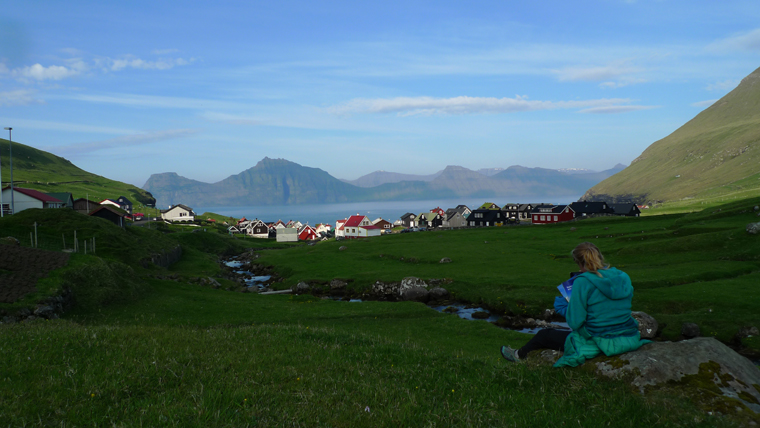
Photography heaven above Gjogv harbour| David Stewart / walkingworld.com
I was happily snapping a turf-topped cottage when the door opened. I beamed an apologetic smile. Bottom lip turned down like a fairytale villain, the old man spat on the ground and shuffled away, head down, muttering.
The Faroese intrigued me. Many of them seemed to have stepped right out of Middle Earth with their high cheekbones, bright blue eyes and ruddy sea-faring complexions. DNA analysis prove the male Faroese line is 87% Scandinavian; the female 84% Celtic. Apparently back in the 880s some Vikings snatched up a handful of Scottish women and set sail to settle the Faroes, and since then they’ve largely kept out of the press.
I had no idea the Faroes is officially part of Denmark but has been trying to win independence for centuries. Gradually this 48,000-strong race won rights to their own government, language, flag and currency, and they celebrate all these successes with national holidays. Clearly enjoying this patriotic theme, and perhaps the days off to go hiking, the Faroese continued with a national flower (the yellow marsh marigold) and a national bird (the oystercatcher).
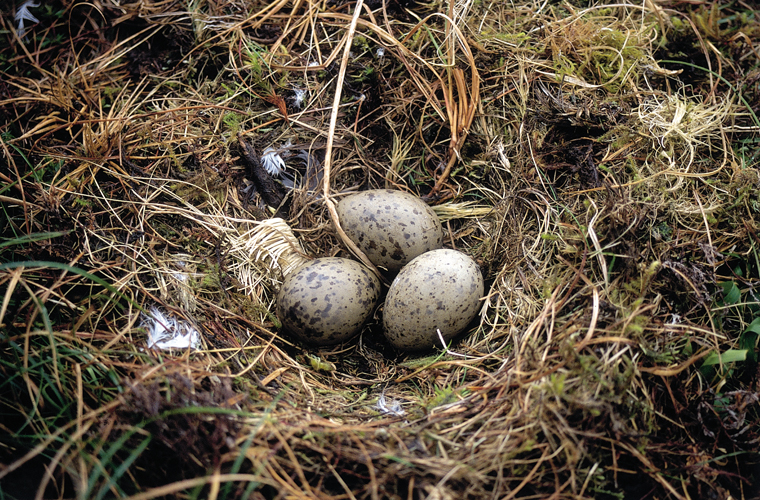
Ground-nesting bird eggs|Absalon Hansen /Visit Faroe Islands
They seem inspiringly unaffected by what the rest of the world gets up to: the Faroese still enjoy singing in harmony over dinner, and a medieval chain-dance that died out in the rest of Europe during, well, medieval times. You take two steps to the left and one to the right, while holding hands and singing an ancient ballad, the owner of our guesthouse in Gjogv explained.
“That one about setting off to kill the Norwegian king has a nice rhythm,” said Bill, hoping to get him going.
Eirik sang shyly, then explained the words: “Sinclair the captain said to the beautiful mermaid: ‘Stupid mermaid, I will kill you.’ So he kills her, and then they all die in a storm.” Then, getting into it, he got us all up and chain-dancing while he launched into another, about a boy growing up and what life would be like for him, fishing, and whale-hunting.
The Faroese passion for these epic songs – some 100 verses long – was a key force behind keeping the Faroese language (essentially an Old Norse dialect) alive despite Danish rule: there was no written form of Faroese until 1854, and Danish was the official national language until as late as 1948.
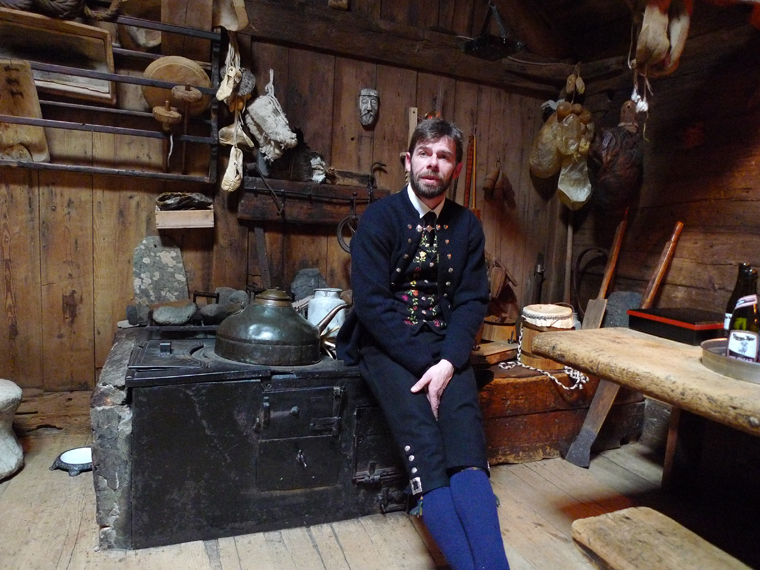
Inside a traditional Faroese farmhouse | David Stewart / walkingworld.com
The Faroese are so Faroese it’s hard to imagine a time when they weren’t here. But actually, for millennia before humans arrived, birds reigned here alone, and on some islands they still rule supreme.
One morning when mist was billowing over the mountains onto the silvery sea and the light was soft and luminous, we took a helicopter to far-flung Svinoy Island. Birds were cacophonous over the tiny harbour: darting, diving and squawking; chasing or enticing each other and us away from their chick stashes. In this topsy-turvy world where birds evolved without any flightless enemies, they’re mostly ground-nesting.
While exploring the vivid green mountainside behind Svinoy’s tiny ramshackle village we nearly tripped over an eider duck’s down-crafted nest, then exclaimed over a dead baby black-backed gull. Marius, the local farmer’s son giving us a hiking tour, explained the fluffy grey chick was playing dead to fool us. Only its black eyeballs moved.
Damp crept down our necks and up our sleeves: we shivered despite our technical outdoor gear. Marius, meanwhile, seemed perfectly snug in standard Faroese outdoor gear: a woolly jumper (carefully darned) and jeans. His curly blonde hair repelled the rain like a sheep’s coat and he simply ignored rain speckling his glasses.
After the walk Marius invited us to sample his mum’s cooking, bearing her a lemony sorrel plant he’d found. We stared in horror at a dish of controversy: 70s-style cocktail stick canapes, but instead of cheese and pineapple, sandwiching black whale meat, squares of whale blubber and a waxy potato. The dried whale was the texture of charcoal; the blubber like rubbery mucus.
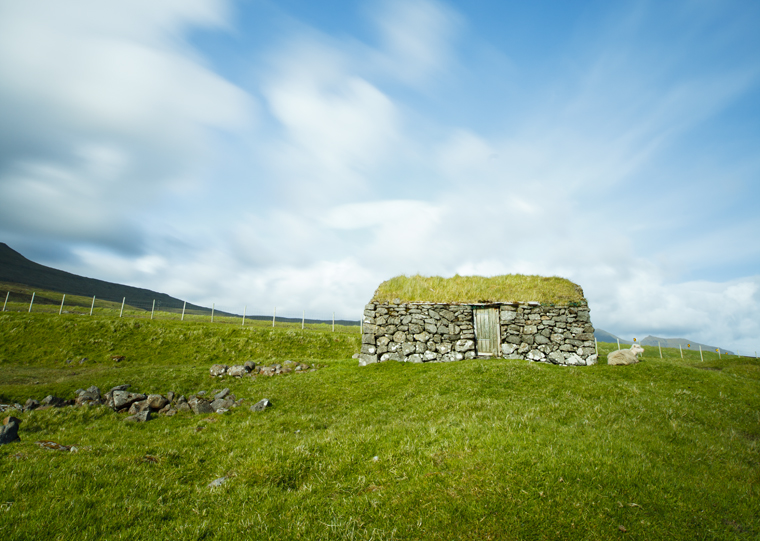
A traditionally-built stone house on the shoreline of Lake Leitisvavatn |Kimberley Coole
The Faroese have apparently been hunting whales since page one of their history books. If settlers saw a pod they’d light a fire; those on the next island would see it, light another and so word would spread, boats launch, and the chase to herd the beasts onto a beach begin. Many Faroese villages survived the winter on dried whale meat in the days before tunnels
and helicopters.
Despite protest campaigns overseas, whale hunting carries on, except nowadays the Faroese apparently only hunt non-endangered pilot whales. The chief of police draws up lists, assigning people to each whale; they then butcher it and take bits home, we were told.
Apart from the occasional excitement when whales swim by, family life on Svinoy revolves around sheep and fish. Like medieval Britain, the Faroes is full of small farms governed by stoutly upheld traditions about common land and fair sheep ownership. At sheep-mustering time, businesses close, and even doctors and heads of government go home to help out on family farms.
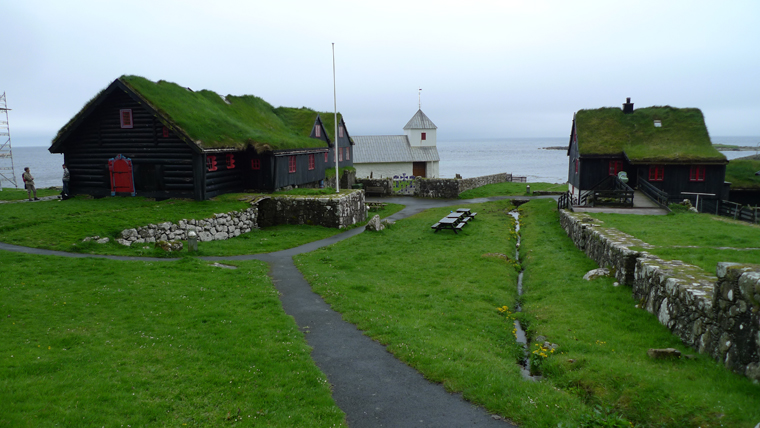
A traditional Faroese farmhouse lived in by the same family for 17 generations |
David Stewart / walkingworld.com
It sounds idyllic, but the family explained that there are fewer people living on Svinoy than there used to be. Having to meet EU regulations has made it too expensive for many small farms to export to Europe. “A vet has to certify every move we make,” they said. “Also, many countries get a quota of more Faroese fish than us.”
As we flew back to the mainland, I looked down on the capital, Torshavn and reflected that the increasingly-slick infrastructure connecting the Faroe Islands, coupled with rising difficulties to live off sheep and fish, has led to their capital growing into a bustling urban centre. Is it on track to become just another consumerist Western culture? Not long after the Faroese jumper fashion craze began, a National Geographic survey named the Faroes ‘world’s most appealing unspoiled island destination’.
Which reminds me, back to the precipice. There we were, creeping towards the seductive melody of the ‘babbling brook’, when suddenly a vortex swirled open in the mist, revealing the Faroese sheep watching us with unattached interest as we stepped towards what was definitely, in fact, a precipice, with the sea thrashing like it was shark infested, far, far, far below. Another bleak cry rang out; this time it was Bill, arms flailing, disappearing into the white. He didn’t even stop to yell, “Save yourselves!” as he ran away, as fast as his legs could carry him.
Mainstream package holiday destination? Probably not for a good while yet.
